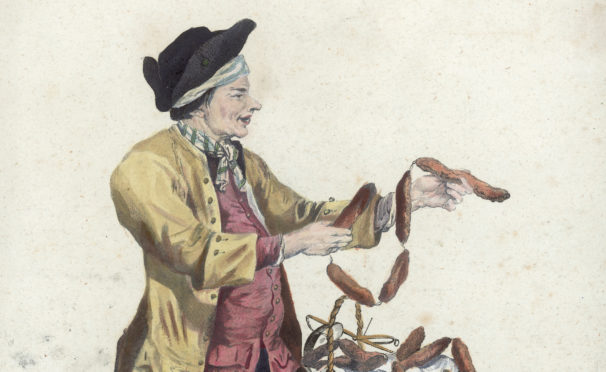
From hotdogs in the States to Scotland’s square slice, sausages are loved the world over.
To mark National Sausage Week, Tristan Powter, sales and marketing director of Powters sausages, tells us why this packaged meat was once banned by the Catholic Church.
What is your job description?
I am marketing and sales director at Powters. We’re a family firm based in Newmarket since 1881 and are originally famous for producing the (now Geographically Protected) Newmarket Sausage. We have nine varieties of sausages available in supermarkets across the east of England, including our Skinny Pig Low Fat Gluten Free.
How did you get into the sausage business?
My background is actually in Commercial Property Law. In 2017, I decided to join the family business and grow the passion to bring better-quality, better-tasting sausages to the nation.
What do you love about sausages?
They’re versatile. They can be cooked as a breakfast, go great in a lunchtime sandwich, they’re awesome when eaten cold and are a crucial ingredient in one of Britain’s favourite dishes – sausage and mash.
Who invented the sausage?
It’s thought sausages are even older than ancient Greece or Rome – the Sumerians (modern-day Iraq) made sausages 5,000 years ago.
When/why did the sausage become so popular in Britain?
It was in the reign of Charles I that sausages were divided into links for the first time in Britain.
How many different kinds of sausage are there in the world and what sets them apart?
Too many to count – there’s about 1,200 different types in Germany alone. Each country (and even counties in the UK) have their own individual take on what makes a great sausage. Most people are familiar with the Bratwurst found in German markets at Christmas. These are usually more firm and spicy than a UK sausage. Hotdogs are a finer blend of meat and often steam-cooked, whereas British sausages tend to be heavy on the pork and mixed with spices or fruit to create combinations such as Lincolnshire sausage, Cumberland sausage or pork and apple. The options are endless.
Scotland is famous for its square sausage. What do you know about that?
This is known as Lorne and is traditionally part of a Scottish cooked breakfast. It’s more like sausage meat as it’s a meatloaf-type dish that is sliced and then fried, with no casings. They are pretty tasty in a cooked breakfast.
What is the skin of a sausage made out of?
Traditionally the skins are natural hog casings from animal intestines – this is the key to a great-tasting sausage and is all we ever use. Many larger manufacturers now cut corners (and costs) by using synthetic skins, which don’t have the same texture or cooking qualities.
What’s your favourite sausage?
Our Newmarket sausage (of course).
Having tried hundreds of different varieties over the years this is still my favourite.
Are vegetarian/vegan sausages becoming more popular?
There is no doubt these health trends are having an influence. There has been a good deal of media spin lately, but we don’t see the nation turning vegetarian anytime soon.
Our philosophy is simple – yes, eating less meat is probably something we should all take on board, but meat can be part of a healthy balanced diet giving us essential proteins and trace elements. We firmly believe the answer is to eat less, but better quality meat – and, importantly, eat meat from Britain.
Tell us something we don’t know about sausages?
In 320 AD, because of their association with pagan festivals, Roman Emperor Constantinus I and the Catholic Church made sausage eating a sin and their consumption was banned. This led to sausages going underground until the ban was lifted.
Another interesting fact about sausages is that 85% of British households buy them an average 12 times a year.
Actor Michael Caine once said: “Forget caviar, sausages are the food of the rich and famous.”

Enjoy the convenience of having The Sunday Post delivered as a digital ePaper straight to your smartphone, tablet or computer.
Subscribe for only £5.49 a month and enjoy all the benefits of the printed paper as a digital replica.
Subscribe